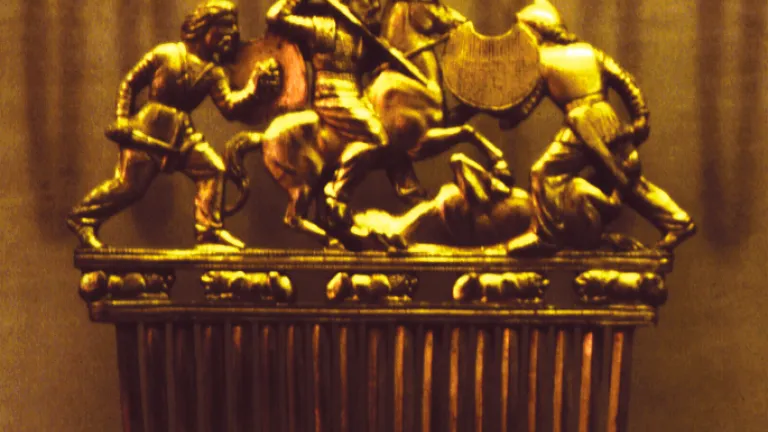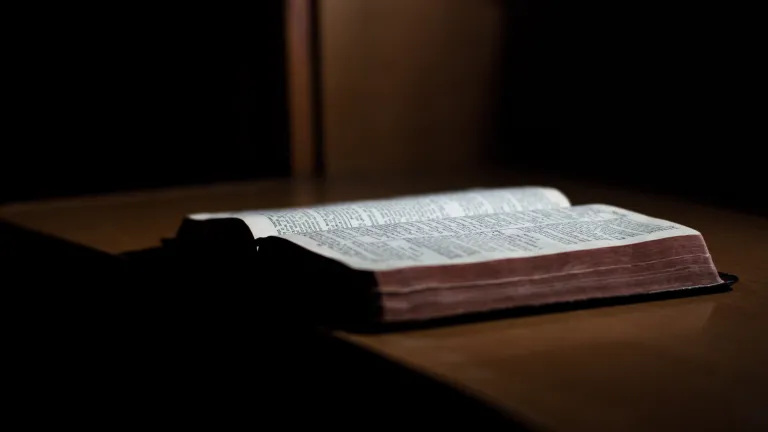Telltale Tracks in More Names, Languages, Archaeology and Art History

We are all products of our ancestral past. The same is true for nations. Once they were tribes, before that they were clans, before that they were families and before that they came from one man-a patriarch.
As we track the 12 tribes of Israel through history and into the future, we need to know their ancestral past. The great patriarch Abraham believed God and obeyed Him (Genesis 12). Thus God chose Abraham and made great promises to him—and by extension to his descendants—of lands and opportunities in the future. And now we pick up the trail of the tribes…
Name tracks
Abraham had only one son by his wife Sarah. Isaac became the next great patriarch. Isaac had a troublesome son Jacob who received the birthright and blessing God had handed down from his grandfather Abraham. Upon Jacob's repentance, God changed his name from "supplanter" or "deceiver" to Israel, meaning "prince with God" (Genesis 32:28). Jacob had 12 sons, each of whom became the patriarch of his own tribe.
The blessings given to the various tribes by Isaac, Jacob and Moses were actually divine prophecies (Genesis 27; 48; and 49; Deuteronomy 33), as we saw in the last article.
In the first installment of our "Tribe Tracker" series we identified the names of Isaac (the father of Jacob) and King Omri of the northern house of Israel as two key names by which the lost 10 tribes can be traced through history. By contrast, the bulk of the Jews, named after the dominant tribe of Judah, always knew who they were.
Isaac's name is found in variations like Saka, Sacae, Scythians, Sacesones, Saxons and others. Omri as a king must have impressed the Assyrians, who conquered and deported the northern 10 tribes, because in their cuneiform tablets and other inscriptions they called the Israelites bit Ghomri or Khumri (house of Omri). Khumri became Cimmeri, Cimmerian, Cymry, etc.
Both the Isaac and Omri derivatives applied to tribal groupings through the centuries. At times a few non-Israelite peoples were either allied with or later labeled by those names because they settled in the land after the Israelites moved on in their migrations.
Each of the 10 tribal names can be found in variations through the centuries on historical atlases (to be presented in the next installment of this series). Additionally, the sons and grandsons of the tribal patriarchs became the clans of each tribe. In tracking the tribes, watch for variations on the names of the clans.
The early Celts in the British Isles often called themselves Brythons or Britons from which Great Britain derives. The Hebrew word for covenant is berit with the consonants of BRT. Thus the Britains essentially called themselves "covenant people."
Language tracks
All 12 of the ancient tribes of Israel spoke Hebrew, and many of the Middle Eastern languages were closely related to it.
Linguistic studies from the late 1700s through the late 1900s have found clear and direct connections between Hebrew and the Celtic or Gaelic languages still maintained in Wales, Scotland, Ireland and the Isle of Man. Going a dramatic step further, many of those studies focused on the remarkable and fundamental commonalities between Anglo-Saxon English and Hebrew. The same connection can be seen in the core words for most of the northwest European languages as well. This is not surprising since those languages were fundamentally the same until about A.D. 500 when the modern nation-states first began to form.
An interesting recent study in 1981 by Professor Terry Blodgett from the University of Utah titled "Phonological Similarities in Germanic and Hebrew" can be downloaded from http://www.originofnations.org/ . This is but one of the many studies that link modern northwest European, English and Gaelic languages to the parent Hebrew language that leave a tribe tracker an imprint to follow.
Archaeological tracks
From the excavations of Celtic burial mounds in Europe to Scythian burial mounds in Siberia, archaeological evidence of the wanderings of the tribes of Israel is abundant. Many of the Scythian finds in Asia reside in Russian museums, but some are readily found elsewhere. The similarities of the Celts and the Scythian cultures are drawn from the assessment of those artifacts.
The Behistun Rock inscriptions comprise one of the great archaeological breakthroughs that unlocked many of the other finds. They are found on a cliff face over 100 meters above the valley floor in the Zargos Mountains of modern Iran along the road from Baghdad to Tehran. A massive inscription and bas relief carving of King Darius I of the Persian Empire (586-521 B.C.), this find shows images of the peoples Darius I had conquered. It describes his victories on parallel columns in three languages: Old Persian, Susian (Elamite) and Akkadian (Assyrian or Babylonian).
The great benefit of the discovery and transcriptions by English soldier Sir Henry Rawlinson is that the languages are translations of each other. In the 1830s and 1840s when he copied the inscriptions in detail, scholars were unable to read the Assyrian-Babylonian language. Assyria, remember, was the conquering and deporting power that took the northern 10 tribes of Israel into captivity.
Sir Henry's younger brother and eminent scholar George Rawlinson clarified how important the inscriptions were to reading the Assyrian tablets excavated from Nineveh in the mid-1800s, thus connecting the lost 10 tribes to the Scythians or Sacae and Cimmerians:
"We have reasonable grounds for regarding the Gimirri, or Cimmerians, who first appeared on the confines of Assyria and Media in the seventh century B.C., and the Sacae of the Behistun Rock, nearly two centuries later, as identical with the Beth-Khumree of Samaria, or the Ten Tribes of the House of Israel" (George Rawlinson, note in his translation of History of Herodotus, Book VII, p. 378).
To a tribe tracker, the Behistun Rock inscriptions are a vital clue on the trail of the wandering tribes of Israel. Archaeologists have also discovered many artifacts that were in fact, art.
Art history tracks
Talented art historians can escort you through museums identifying historical paintings and other art pieces, and talk at length about the era and culture of the art. Art history courses provide direct visual access to archaeological evidence of the ancient past.
The Scythian-Cimmerian art forms clearly reveal a common culture. Hard art pieces (gold, silver, bronze, stone, pottery, etc.) survive for modern archaeologists to find. Ditto with many Scythian-type artifacts. One of the great collections of Scythian-Sacae art resides in the Hermitage Museum of St. Petersburg, Russia. These pieces define the characteristic Scythian animal style:
"The term Animal Style is used to describe a tradition characteristic of the applied—or rather portable—art of a number of ancient nomadic peoples. Animals were considered to have magical power and to provide protection against evil or disaster and representations of them thus occupied an important place in life. This style reflected the mythology, the ethical and aesthetic ideals of the warrior-nomad.
"With a magnificent understanding of composition and the essential nature of the material, craftsmen fashioned utilitarian objects in animal form: weaponry, horse trappings, clothes, ornaments and jewelery and other everyday objects were all decorated with zoomorphic [animal] motifs. Without copying nature, they accurately conveyed the essence of every beast depicted.
"The highly stylized modeling uses bold accentuated planes, while distinctive features associated with particular species are emphasized and exaggerated. Zoomorphic motifs were used not simply for decorative effect, but to turn the object into amulets, with magical power to assist in hunting, and to protect the owner from harm" (http://www.hermitagemuseum.org).
In reference to the use of the animal-shaped art as idolatrous, magic amulets at times, it is well to remember that God sent the northern 10 tribes into captivity precisely because of their idolatry. "In the ninth year of Hoshea, the king of Assyria took Samaria and carried Israel away to Assyria, and placed them in Halah and by the Habor, the River of Gozan, and in the cities of the Medes. For so it was that the children of Israel had sinned against the Lord their God… for they served idols, of which the Lord had said to them, 'You shall not do this thing'" (2 Kings 17:6-7, 12).
Scythian and Celtic art was fundamentally the same from the borders of China (where certain of the Sacae harassed the Chinese frontiers for several centuries) to the British Isles. The animal style links wandering Israelites together.
Celtic art styles assumed the Scythian influence in the sixth and fifth centuries B.C. as the Cimmerians migrated across Asia Minor into Europe to link with their early Celtic relatives. Thus art history, when you know what to look for, provides another trail for the tribe tracker.
Tracks tell tales
These telltale tracks in the names, languages, archaeology and art history of the descendants of the so-called "lost" 10 tribes of Israel help us follow them through time. We observe God's hand in bringing them to the new homelands He had promised to Abraham. Sleuthing through history also adds remarkable depth to one's thinking and makes the story of man all the more fascinating.
Generally, the academic establishment ridicules or rejects the idea that the Bible is directly connected to human history. Why would they do that? The answer is simple. They do not like to retain God in their knowledge (Romans 1:28; see also 18-32). The "wise" of this world often ignore evidence that points to God and His work with mankind. True wisdom starts with the Word of God and goes from there.
The next article in the "Tribe Tracker" series will let you soar over lands and through time in a broad overview of the movements of the tribes through the centuries in "Tracking the Tribes Through Migrations and Maps." If you have not read the previous article in this series, you can find it at: "The Tribe Tracker's Guide to the Future"
In the meantime, if you haven't already read the foundational booklet on this subject, please download or order your free copy of The United States and Britain in Bible Prophecy. This well-researched study aid will put it all in biblical perspective.







